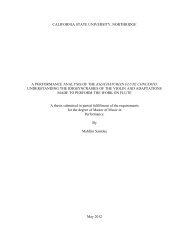2644 - CSUN ScholarWorks - California State University, Northridge
2644 - CSUN ScholarWorks - California State University, Northridge
2644 - CSUN ScholarWorks - California State University, Northridge
You also want an ePaper? Increase the reach of your titles
YUMPU automatically turns print PDFs into web optimized ePapers that Google loves.
2780<br />
Journal of Student Research Abstracts · 63<br />
DROSOPHilA AND THE RAYS OF AGE® ULTRAVIOLET LIGHT IN SPECIFIC<br />
RELATION TO SEX RATIO OF OFFSPRING PER EXPOSED PARENT<br />
GENERATION.<br />
Timothy Daniel Schroepfer, Steve DeGusta (teacher). John F. Kennedy Senior High School, 6715 Gloria<br />
Drive, Sacramento, CA 95831.<br />
What environmental factors account for the imbalance of male and females with in the human population?<br />
It was the opinion of the study that ultraviolet light, a known mutagen, could cause this imbalance in the sex<br />
ratio. The study used Drosophila melonagaster (the common fruit fly) due to it quick reproduction rate. A virgin<br />
parent generation was exposed to 5 minutes of full spectrum ultraviolet light. They were then paired off<br />
and left to breed. The resulting offspring of the exposed flies were then compared to control sample of normally<br />
bred flies kept under the same conditions. The result indicated that there was not significant difference<br />
with a chi squared calculation resulting in a p value of almost one. This indicates that the results were due to<br />
chance variation and not due to the ultraviolet light. While ultraviolet light cannot be ruled out as a sex determinate<br />
it can be said that the probability that it has anything to do with sex outcome is very limited.<br />
2781<br />
MOLD GROWTH AND ITS EFFECTS WITH WATER ON SOURDOUGH,<br />
WHITE AND WHEAT BREAD<br />
Brian Chan, Steve DeGusta (teacher). John F. Kennedy High School, 6715 Gloria Drive, Sacramento, CA<br />
95831.<br />
In this experiment I tested to see if water had an effect on the amount of mold growth on sourdough, white<br />
and wheat bread. I hypothesized that all the bread that was watered would have more mold growth than the dry<br />
control breads. To do. this I took 10 pieces each of white, wheat and sourdough broad and cut each slice into<br />
four inch by four inch squares. I added 20 drops of water on each piece of bread and placed each piece of bread<br />
in its own individual plastic zip lock bag. Almost any nutrient-rich material such as bread will go mouldy if<br />
the environmental conditions like temperature and moisture level are suitable for mould growth. For my control<br />
I took 10 pieces of each kind of bread and placed them in the plastic bags minus the water. After four days<br />
mold started to grow on the bread. After seven days I took each individual piece of bread, placed a piece of<br />
transparent graph paper over it and counted the number of squares the mold covered. I then found the area of<br />
bread the mold covered and concluded that mold on bread with water added to it would grow faster than bread<br />
without water. None of my control breads had any mold growth, while the watered sourdough bread had mold<br />
growth on 1.54 cm 2 of bread, the watered white bread had mold growth on 14.21 cm 2 of bread, and the watered<br />
wheat bread had mold growth on 19.36 cm 2 of bread. With a p-value













